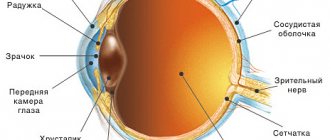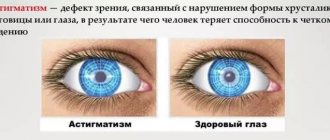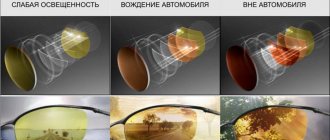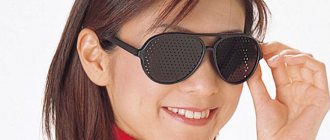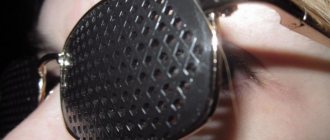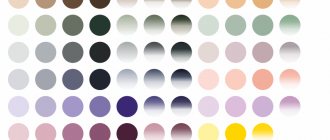Sports glasses are designed to reliably protect children's eyes from injury. What they should be - you will find the answer to this and other questions about children's sports glasses in our material.
- Can a student use his regular corrective glasses during sports activities?
- What are the characteristics of high-quality sports glasses for children?
- Do children whose vision does not require correction need sports glasses?
- Is it possible to use contact lenses instead of sports glasses during sports activities?
- Which manufacturers specialize in the production of children's sports glasses?
- What is important for an optician to consider when deciding to include sports glasses for children in their salon’s assortment?
- Which sports glasses are easier to sell: children's or adults?
- What are the consequences of playing sports without glasses for people with glasses?
Children's eye injuries during sports are far from rare. Thus, in the USA, according to statistics, sports eye injuries in children occur every 13 minutes. This is more than 200 thousand cases per year! Sports glasses are designed to reliably protect children's eyes from injury. What they should be - you will find the answer to this and other main questions in our material today.
Can a student use his regular corrective glasses during sports activities?
Using regular prescription glasses while playing sports may not be safe because most glasses are not suitable for this purpose. In this regard, we especially note glasses with frames made of metal alloys, which have a shape memory effect, thanks to which they easily return to it even after severe deformation. Due to the fact that such glasses are not easy to break, they are often recommended for children. However, they are not the best option for sports activities. Let's explain why. After deformation as a result of a hit with an elbow or, say, a ball, such glasses really easily return to their previous form. They are not afraid of a blow, which, unfortunately, cannot be said about their young user. Due to the high flexibility of the material, usually due to the presence of nickel in it (its share can reach 50%), the frame in the place where the impact occurs “bites” into the face, and this can be fraught with unpleasant consequences. In addition, the presence of nickel in the metal alloy from which the frame is made can cause an allergic reaction in the glasses user, which is aggravated by the influence of salt and acid solutions that contain human sweat, which is actively released during sports.
What are the characteristics of high-quality sports glasses for children?
These include the following:
- The frame of the glasses is made of safe plastic, which does not form splinters if damaged. This could be, for example, nylon or grilamid TR-90.
- The frame has no metal parts or sharp corners.
- The glasses are equipped with an elastic band that ensures their secure fixation. Some manufacturers, in the accompanying instructions for their glasses, inform that this model is suitable for sports only if they are secured with a bandage.
- The glasses are equipped with impact-resistant lenses made from materials suitable for use in potentially hazardous situations (for example, polycarbonate, Trivex or tribrid).
- The inner side of the bevel groove is higher than the outer one, so that during an impact the lenses would not be squeezed back, but, on the contrary, would fall forward.
- The shape of the model is designed in such a way that the frame is at the level of the bones of the orbit, which allows you to avoid damage to the eyes in the event of an impact.
- The area of the nose part of the frame is at least 300–400 m2, which allows for optimal distribution of the weight of the glasses.
- The glasses are equipped with shock absorbers in the nose and temple parts.
- The glasses are light in weight and fit well on the face.
- When used outdoors, the glasses provide 100% protection against ultraviolet radiation, excessive sunlight and glare.
- The glasses fit well to the side of the face, preventing sunlight from entering from the side.
In order for the weight of sports glasses to be distributed evenly, their nose part must have an area of at least 300–400 mm2
Sports glasses with prescriptions - Rupp Hubrach SPORTS lens series
Relaxing in sports sunglasses at any time of the year is always fun and pleasure. During the warm season, everyone strives to increase their activity. At this time, the number of users playing sports on the street almost doubles.
Those who need vision correction are in a different situation. Just 10 years ago, glasses with diopters for sports were a novelty. The fact is that the tight-fitting designs required highly curved lenses, and besides, the non-standard position of the lens in front of the eyes required taking this parameter into account in the design of the lens surface.
However, back in 2001, the German company Rupp + Hubrach offered customers a special series of “sports” lenses SPORTS of the highest class. Almost 20 years have passed since then, and today r+h is considered the ancestor and founder of the class of spectacle lenses with a high base curvature, which is more often called simply “sports”.
Catalog of sports lenses with diopters.
Clear vision across the entire surface of the R+H SPORTS sports lens
You will be surprised, but many professional athletes wear sports glasses frames with diopters. Even participating in title competitions. And the army of active pastime lovers is many times larger.
Often, people cannot afford to engage in sports recreation because they require vision correction. However, now optical technologies will allow anyone to play their favorite sports.
For example, German brand lenses with a high base curvature Rupp + Hubrach SPORTS 1.67 will provide sharp and accurate vision when playing any sport.
They are available in several types of “base curvature” (the level of “curvature” of the lens) - BC4, BC5, BC6, BC7 and BC8 - which allows installation even in tightly fitting frames.
Spectacle lenses such as the r+h SPORTS 1.67 are designed for installation in designer fitted frames or sports glasses. They have a super-high refractive index n=1.67, making these sports lenses, even at very high diopters, 34% thinner and more aesthetically pleasing than standard ones.
For professional sports professionals, Rupp + Hubrach offers customized lenses in the “free” series, for example r+h SPORTS free 1.67. This series is manufactured using the “Free Form” technology, taking into account the individual parameters of the athlete, which guarantees careful processing of the product and standard vision quality.
r+h SPORTS free 1.67 are made from extra durable MR-9 material (5 times stronger than standard lenses) and are optionally available in over 208 color shades.
Sports glasses with prescriptions - it's easy!
Do you want to know which lenses for sports glasses are suitable for your dioptres and the selected frame? Just call the Opticbox service department at 8 800 777 5929 or write to [email protected]
We will quickly offer several options to choose from.
OpticBox - glasses delivered to your home.
Do children whose vision does not require correction need sports glasses?
Typically, parents whose children do not have vision problems answer this question in the negative, underestimating the risk of eye injury. Its most common cause in physical education classes is a collision with other students during team games (such as football or basketball), when the guys, wanting to take the ball, make dangerous movements near the opponent's face. In this case, a blow with a fist, elbow or even knee can cause injury. Along with team games, the risk of eye injury is present in sports that use rackets (squash, badminton, tennis), as well as bats and sticks (all types of hockey, baseball). Thus, the eyes of any child require protection, and therefore sports It is recommended to wear glasses not only for those guys whose vision needs correction - they will not hurt all other players either!
Choosing optics depending on the type of activity
According to the Hamburg account, all optics are divided into:
- Corrective optics
- Sun protection fashion
- Protective sports
- Just protective
Sometimes some types of activities require very precise movements, and if glasses interfere (slip, fog up, press), then it becomes simply impossible to play sports. For example, if your glasses fog up during a marathon, “welcome to hell,” but if you are climbing a rock and your glasses crawl up your nose, then you will think about anything but a difficult route. Upon closer examination, the most important difference between sports optics and other types of glasses is unprecedented comfort, light weight and protection from various factors.
Since there is a wide variety of activities, the threats to the eyes can be different, because we remember that we are protecting ourselves not only from the sun. For example, even if you are just riding a bike in the park with your child, you will inevitably have to protect your eyes from midges, dust and wind. Conversely, when training on a cross-country ski slope, you don't want to suffer from snowflakes, pieces of ice and icy wind. When playing sports at dusk, which, by the way, is not at all uncommon, you do not need SUNGLASSES, you will need SAFETY glasses.
When developing a new glasses model, engineers first of all think about where and who will use it. That is why sports models differ from one another not only in lenses, but also in design as a whole.
If you come across a seller’s announcement about the versatility of the model, this should alert you. There can be no truly universal glasses!
There are two competing ideas when designing glasses: on the one hand, glasses should provide maximum protection, preferably fitting tightly to the face, and on the other hand, they should provide good ventilation.
If you are a climber, then most likely choose glasses that fit your face tightly and do not let in even a small ray of light. But if you try to ride a bike, ski or just run in these glasses, they will fog up.
A fan of cyclical sports (running, marathon, cross-country skiing) needs glasses with improved ventilation, which means these glasses will have large side clearances.
There are sports, for example, ski mountaineering, where you have to “sweat” at a fairly high altitude, and for this there is a rather limited list of “pseudo-universal” models. Developers go to great lengths to ensure acceptable ventilation with sufficient protection:
- ventilation slots of tricky geometry;
- modified optical glass geometry;
- perforated nose pads, etc., etc.
But before we talk about the various design details, we must get acquainted with the main materials that are used in the production of glasses.
Is it possible to use contact lenses instead of sports glasses during sports activities?
It's possible. Even a six-year-old child, as a rule, can already remove and put on contact lenses and care for them independently. If he plans to wear contact lenses only during sports activities, daily disposable contact lenses are, of course, preferable, since this will eliminate the problem of maintenance. Being located directly on the eye, the contact lens creates a single optical system with it, eliminating the limitation of fields of view and optical distortion of objects when looking to the side and practically without changing the size of the image. Multifocal lenses, which have both near and distance zones, may also be useful in preventing the progression of myopia. The only “but”: contact lenses, unlike sports glasses, cannot protect your eyes from injury.
Sports glasses frame
I've seen glasses without lenses, but it's hard to imagine sports optics without frames, so let's talk briefly about frame materials.
Glasses frame materials
Perhaps the most common material for sports frames is grilamid . It comes in different densities, weights and strengths. It is cheap, easy to manufacture, easily extruded and subject to a wide variety of finishing options.
When creating lightweight glasses models, nylon (nylon) . The material is light and elastic, but not hard enough.
Some mountaineering eyeglass frames are made from metal , following time-tested and beloved traditions. There is no need to talk about significant advantages, but they look “rich” and not “like everyone else.”
Shape, geometry and some design features of frames
Sports glasses come in full-frame and half-frame . Semi-frames often come with interchangeable lenses. And if you need glasses with guaranteed ventilation, choose half-frame models. Sometimes it blows so hard that it brings out tears, no fogging
Semi-frames often come with interchangeable lenses. And if you need glasses with guaranteed ventilation, choose half-frame models. Sometimes it blows so hard that it brings out tears, no fogging
Tight-fitting, full-frame glasses often have a panoramic view, reduced ventilation, and are heavier, but provide better protection from the negative influences of the external environment.
Which sports glasses are easier to sell: children's or adults?
According to experts, counseling clients regarding children's glasses takes more time and requires more effort than when seeing adult patients. After all, you first need to convince parents that sports glasses are an important and useful investment, and then choose a glasses option that both parents and child would like. Otherwise, he will not wear them, and the investment will automatically turn into useless. It is useful for both parents and children to know that children's sports glasses, while protecting their eyes from injury, perform the same protective function as a helmet in cycling or knee and elbow pads in roller skating, so they should not be put off by the fact that they will “clutter up” "child's face.
Children's sports glasses perform a protective function in relation to the eyes, so parents should not be put off by the fact that they will “clutter up” the child’s face
What are the consequences of playing sports without glasses for people with glasses?
The relationship between good vision and success in sports has been confirmed by many studies.
Children with vision problems who attend physical education classes without glasses or contact lenses perform worse than their emmetropic classmates. This is especially true for coordination and balance exercises. In addition, due to poor vision, children are more susceptible to injuries, and not only to the eye. A person’s eyes occupy less than 1% of the surface of his body, and therefore, when playing sports, they are injured, fortunately, less often than other organs. However, due to the functional importance of the eyes and the delicate nature of their tissues, they require reliable protection, which the right sports glasses can provide. * Injuries usually occur when players play in pairs.
Elena Chulanova
Other related articles:
